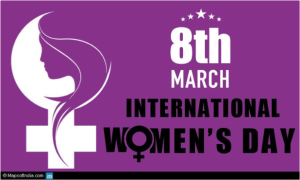International Women’s Day

The Charter of the United Nations, signed in 1945, was the first international agreement to politically affirm the principle of equality between women and men. Since then, the UN has made a commitment to the advancement of the status of women worldwide. After the women’s labor movements at the turn of the twentieth century in North America and across Europe, the UN decided to hold International Women’s Day every year on March 8th to celebrate the progress of women and look toward what is needed in the future.
The theme for International Women’s Day 2016 is achieving gender parity: equality regarding status or pay. Although women are often misconceived as having equal opportunity to jobs in the western world, equally qualified women are still earning 78 cents to every dollar that a man makes for doing the same work. Hispanic and black women earn even lower average wages of 64 cents and 56 cents respectively. Although we have come along way since the Civil Rights Movement, progress towards gender parity has increasingly slowed.
The World Economic Forum predicted in 2014 that it would take until 2095 to achieve global gender parity. Then one year later in 2015, they estimated that a slowdown in the already glacial pace of progress meant the gender gap wouldn’t close entirely until 2133. With factors such as climate change, inflation, and unpredicted recessions, women are often the ones to be laid off first. There is an assumption made by employers that that women will not invest as much time into a company and will leave to start a family or be the primary care giver—an assumption not made about men. Consequently, with theories of “diversity” and “inclusion” increasing as marketing strategies in the workforce, so does the tokenism of women, creating the illusion of growth.
The UN commits to concrete and pragmatic growth, recognizing women for their achievements without regard to divisions, whether national, ethnic, linguistic, cultural, economic or political, and because of this, International Women’s Day has become a holiday celebrated worldwide. Every year, women from around the world gather at the United Nations Headquarters in New York to participate in the Commission on the Status of Women, the principal global policy-making body dedicated exclusively to gender equality and the advancement of women.
At the CSW, Representatives of UN Member States gather with leaders from global non-profits and organizations committed to helping women, as well as youth delegates from around the world to evaluate progress on gender equality. Through a series of panel discussions, speak-outs, and working group meetings, these women work together identify challenges, set accomplishment goals, and create concrete policies to promote the advancement of women worldwide.
Today, on International Women’s Day, we must examine the root of why we have to celebrate, not “commemorate” the accomplishments of women in the first place—because every other day of the year, women still remain on the margins of society. To commemorate is to respect and celebrate, but also to serve as a memorial to past accomplishments. On International Women’s Day, we must recall the past in order to progress towards the future. Let us use this recognition as a platform of power, while being cautious as to not promote a mask over our success and achievements.

![[in]Visible Magazine](https://community.scrippscollege.edu/invisible/wp-content/uploads/sites/5/2011/04/Invisible-Masthead-2011-Spring1.png)







Comments are closed.